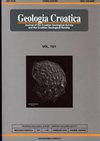河南灵宝范岔金矿成矿流体
IF 1.1
4区 地球科学
Q3 GEOLOGY
引用次数: 0
摘要
范岔金矿床是小秦岭金矿区含金石英脉型金矿床的代表,成矿流体是矿床形成的关键控制因素之一,也是矿床研究的重点。本文详细介绍了凡查矿床的地质特征和流体包裹体,描述了流体的潜在起源和演化以及矿床的成因。野外调查和岩相学观察表明,范岔矿床矿体主要赋存于太华群角闪岩中,受脆性断裂控制。Fancha矿床的热液蚀变包括硅化、钾长石化、绢云母化、黄铁矿化和碳酸盐化。矿物组合、横切和交代关系表明,成矿过程可分为石英-钾长石(I)、石英粗黄铁矿(II)、石英细黄铁矿(III)、石英多金属硫化物(IV)和碳酸盐岩阶段(V)。金主要在第三和第四阶段沉淀。根据室温下的特征,在Fancha矿床中发现了三种类型的流体包裹体:三相富CO2、三相含CO2和两相含水包裹体。流体包裹体在第二阶段、第三阶段、第四阶段和第五阶段分别表现出363.3℃、325.5℃、273℃、258.62℃的均化温度和14.53、9.59、11.61、8.03 wt%NaCl当量的盐度模式。Fancha矿床成矿流体属于中低温、中低盐度的CO2-H2O-NaCl-(±CH4)流体系统。成矿流体的δ18OH2O在1.36到6.28之间,δDH2O在-87到-53.1之间。氢氧同位素数据表明,成矿流体早期以变质流体为主,后期变质流体逐渐与循环大气降水混合。岩石学观察和显微测温表明,成矿主期流体混合和不混溶现象明显。流体混合和流体不混溶可能导致Fancha矿床中的金沉积。本文章由计算机程序翻译,如有差异,请以英文原文为准。
Ore-forming fluids of the Fancha gold deposit, Lingbao, Henan Province
The Fancha gold deposit is a representative of the auriferous quartz vein type gold deposits in the Xiaoqingling gold district where the ore-forming fluid is one of the key controlling factors in the deposits formation, and also the main focus of ore deposit research. Here, the geological characteristics and fluid inclusions of the Fancha deposit are presented in detail, with a description of the potential origin and evolution of the fluid and the genesis of the deposit. Field investigation and petrographic observation show that ore-bodies in the Fancha deposit are preferentially hosted in the amphibolites of the Taihua Group and are controlled by brittle fracture. Hydrothermal alteration in the Fancha deposit includes silicification, potash feldspathization, sericitization, pyritization and carbonatization. The mineral assemblage, cross-cutting and replacement relationships indicate that the ore-forming process can be divided into quartz-K-feldspar (I), quartz-coarse pyrite (Ⅱ), quartz-fine pyrite (III), quartz-polymetallic sulfide (IV) and carbonate stages (V). Gold is mainly precipitated in stages III and IV. Three types of fluid inclusions have been identified in the Fancha deposit, based on their characteristics at room temperature: three-phase CO2-rich, three-phase CO2-bearing and two-phase aqueous inclusions. The fluid inclusions demonstrate the modes of homogenization temperatures of 363.3℃, 325.5℃, 273℃, 258.62℃ and salinities of 14.53, 9.59, 11.61, 8.03 wt% NaCl.equiv., for stages II, III, IV, and V respectively. The ore-forming fluid in the Fancha deposit belonged to the CO2-H2O-NaCl-(±CH4) fluid system with mid-low temperature and mid-low salinity. The δ18OH2O of the metallogenic fluids was between 1.36 and 6.28, and the δDH2O was between -87 and -53.1. Hydrogen and oxygen isotope data indicate that the ore-forming fluids were dominated by metamorphic fluids in the early stage, and that the metamorphic fluid gradually mixed with circulating meteoric water during the later stages. Petrographic observation and microthermometry suggest that fluid mixing and immiscibility obviously occurred during the main metallogenic stage. Fluid mixing and fluid immiscibility probably led to gold deposition in the Fancha deposit.
求助全文
通过发布文献求助,成功后即可免费获取论文全文。
去求助
来源期刊

Geologia Croatica
GEOSCIENCES, MULTIDISCIPLINARY-
CiteScore
2.90
自引率
23.10%
发文量
35
审稿时长
>12 weeks
期刊介绍:
Geologia Croatica welcomes original scientific papers dealing with diverse aspects of geology and geological engineering, the history of the Earth, and the physical changes that the Earth has undergone or it is undergoing. The Journal covers a wide spectrum of geology disciplines (palaeontology, stratigraphy, mineralogy, sedimentology, petrology, geochemistry, structural geology, karstology, hydrogeology and engineering geology) including pedogenesis, petroleum geology and environmental geology.
Papers especially concerning the Pannonian Basin, Dinarides, the Adriatic/Mediterranean region, as well as notes and reviews interesting to a wider audience (e.g. review papers, book reviews, and notes) are welcome.
 求助内容:
求助内容: 应助结果提醒方式:
应助结果提醒方式:


